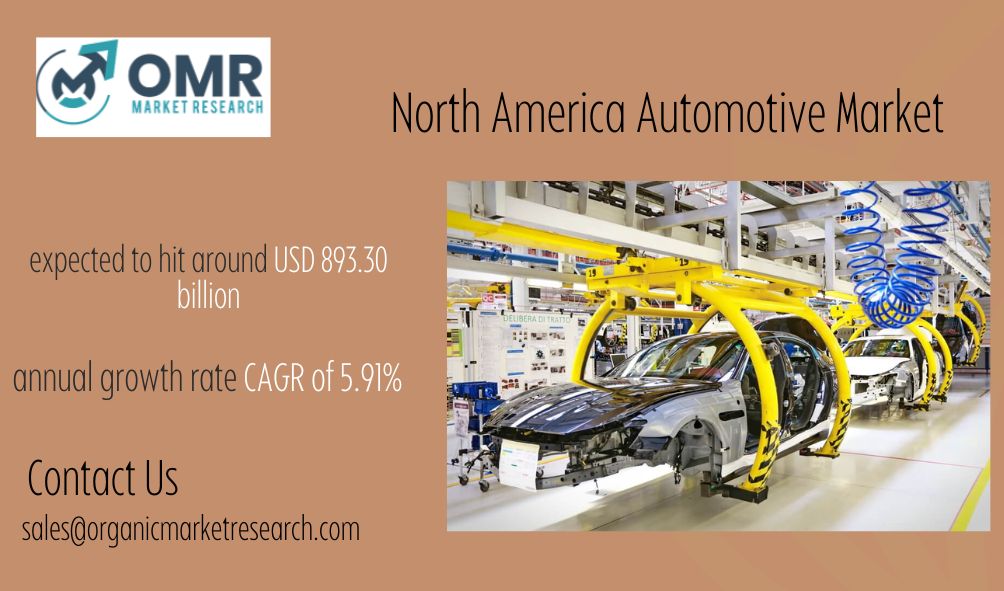North America Automotive market size was USD 893.30 billion in 2023 and the market is projected to touch USD 1,498.29 billion by 2032, at a CAGR of 5.91% during the forecast period. The market has undergone substantial changes in recent years, owing to technology improvements and shifting consumer tastes. Key trends include increased demand for electric vehicles (EVs) as a result of environmental concerns and government incentives, as well as the incorporation of improved safety and connectivity technologies in vehicles. These innovations are altering the competitive landscape, with traditional automakers competing with new entrants in the EV industry and IT companies investing in autonomous driving technologies.
Regulations aimed at lowering emissions and improving fuel efficiency also have an impact on the market, driving automakers to engage in alternative powertrain research and development. This includes hybrid vehicles and hydrogen fuel cells, which are potential alternatives to standard gasoline engines.

Moreover, consumer behaviour is evolving with a shift towards online car shopping and subscription-based models, challenging traditional dealership networks. This digital transformation is accompanied by investments in artificial intelligence and data analytics to personalize customer experiences and optimize operations.
North America Automotive report scope and segmentation.
North America Automotive dynamics
Technological innovations, particularly in electric cars (EVs) and self-driving technology, are altering the business. Government subsidies, environmental restrictions, and consumer desire for environmentally friendly transportation options are all driving up EV adoption. This trend is forcing conventional automakers to spend extensively in EV manufacturing capabilities, while new entrants emerge, increasing competition.
Furthermore, legislative reforms aimed at improving emissions standards and fuel efficiency are spurring innovation in alternative powertrains like hybrids and hydrogen fuel cells. Automakers must manage these laws to meet compliance and satisfy consumer aspirations for cleaner, more efficient automobiles.
Consumer behaviour is evolving with the rise of digital platforms for car shopping and ownership, influencing how automakers and dealerships interact with customers. There’s a growing preference for online transactions, subscription-based models, and personalized vehicle experiences supported by artificial intelligence and data analytics.
Furthermore, supply chain disruptions and material shortages, exacerbated by global events like the COVID-19 pandemic, have underscored the industry’s vulnerability to external shocks. These challenges highlight the importance of resilient supply chain management and diversification strategies to mitigate risks and maintain production continuity.
North America Automotive drivers
Technological Advancements
Technological improvements, notably in electric cars (EVs) and self-driving technology, are significant drivers of the North American automotive sector. Environmental restrictions aimed at lowering greenhouse gas emissions, as well as customer demand for sustainable transportation alternatives, are driving the shift to electric vehicles. Government incentives, such as tax credits and subsidies for EV purchases, help to speed adoption. Automobile manufacturers are investing extensively in EV research, development, and manufacturing facilities to fulfil rising demand and regulatory requirements. Similarly, improvements in autonomous driving technologies promise greater safety, convenience, and efficiency, influencing the future of transportation solutions in the region.
Shift in Consumer Preferences
Changing consumer preferences are another major factor influencing the North American car market. Consumers are increasingly valuing connectivity, safety features, and digital experiences in vehicles. There is an increasing demand for connected vehicles outfitted with advanced entertainment systems, integrated navigation, and smartphone connectivity. Furthermore, there is an increased interest in subscription-based models and online auto shopping platforms that provide convenience and flexibility. Automakers and dealerships are responding by improving their digital presence, providing individualized customer experiences using AI-driven technology, and modifying their sales and service methods to meet changing consumer expectations.
- Restraints:
Supply Chain Disruptions
The North American automotive market is facing supply chain disruptions and material shortages, which are worsened by global events like the COVID-19 epidemic. Disruptions in the supply chain can cause production delays, increased expenses, and inventory shortages, limiting automakers’ ability to meet consumer demand and fulfil orders on time. Managing supply chain resilience, diversifying sourcing strategies, and implementing flexible manufacturing practices are critical for managing these risks and preserving operational continuity.
Regulatory Challenges
Regulatory challenges pose significant restraints in the North America automotive market. Evolving emissions standards, fuel efficiency regulations, and safety requirements necessitate continuous adaptation and investment from automakers. Compliance with stringent regulations requires significant research and development investments in new technologies, which can strain resources and impact profitability. Moreover, differing regulatory landscapes across North American jurisdictions can create complexity and uncertainty, influencing business strategies and product offerings.
- Opportunities:
Expansion of Electric Vehicles
The increasing usage of electric vehicles creates enormous potential opportunities in the North American automotive market. As governments and customers prioritize sustainability, automakers may benefit on rising EV demand by broadening their vehicle lineups, improving charging infrastructure, and developing advance battery technologies. Collaborations with technology firms and energy providers to establish EV ecosystems and smart charging solutions increase market prospects.
- Segment Overview
Passenger cars encompass a wide range of vehicles designed primarily for transporting passengers. These include sedans, hatchbacks, coupes, and convertibles, among others. They are typically used for personal transportation and offer varying levels of comfort, performance, and features. Passenger cars represent a significant portion of the automotive market, with consumer preferences shifting towards fuel-efficient models, electric vehicles (EVs), and vehicles equipped with advanced safety and connectivity technologies.
Commercial vehicles are required to transport goods and passengers for business operations. Light commercial vehicles, which include vans, pickup trucks, and utility vehicles, are typically used for small-scale transportation and delivery. Trucks, buses, and trailers are examples of medium and heavy commercial vehicles that are designed to move heavier goods over long distances. These vehicles are essential for logistics, construction, public transportation, and other business operations. Economic developments, infrastructure development, and pollution and safety regulations all have an impact on the commercial vehicle industry.
Motorcycles, scooters, and mopeds are examples of two-wheelers, which can be driven by one or two people. They are popular for personal transportation, particularly in urban regions with heavy traffic. Two-wheelers provide affordability, agility, and fuel efficiency, appealing to consumers looking for cost-effective mobility alternatives. The market for two-wheelers is driven by urbanization, rising fuel prices, and increasing demand for eco-friendly transportation options. Manufacturers are introducing electric two-wheelers to meet environmental regulations and cater to the growing preference for sustainable mobility solutions.
North America Automotive Overview by Region
The region has a vast and mature automotive sector, with the United States accounting for the largest market in terms of volume and revenue. In the United States, consumer tastes drive demand for a wide range of cars, including SUVs, trucks, and electric vehicles (EVs), with an increasing emphasis on connection and autonomous technologies.
Canada’s automotive sector is critical to its economy, with a large number of vehicle assembly plants and a sizable export market, primarily to the United States. The Canadian market is driven by government regulations promoting sustainable energy and vehicle electrification, as well as a solid demand for light trucks and SUVs.
Mexico has emerged as a crucial manufacturing hub within the North American automotive landscape, hosting numerous production facilities operated by global automakers. The country benefits from its proximity to both the U.S. and Canadian markets, favourable trade agreements such as USMCA (United States-Mexico-Canada Agreement), and competitive labor costs. Mexico’s automotive industry contributes substantially to its economy through exports and employment, with a focus on producing small cars, pickups, and components.
North America Automotive market competitive landscape
Established automakers such as General Motors, Ford, and Stellantis (formerly Fiat Chrysler) dominate the market, offering vast product portfolios that include passenger cars, SUVs, trucks, and, increasingly, electric vehicles. These firms invest extensively in R&D to innovate in areas like as EV technology, autonomous driving, and connected vehicle platforms, with the goal of meeting severe regulatory requirements and market demand for sophisticated features.
Simultaneously, Tesla is a disruptive force, dominating the EV market with creative designs and technological improvements in battery technology and autonomous driving. Its success has pushed other automakers to speed up their EV ambitions and invest in rival electric vehicles. Moreover, tech giants like Google’s Waymo and Apple’s automotive ventures are reshaping the competitive landscape by focusing on autonomous driving software and mobility solutions, potentially disrupting traditional automotive business models.
Beyond vehicle manufacturers, suppliers of automotive components and systems play a critical role in the market’s competitiveness. Companies like Bosch, Continental, and Magna International provide essential technologies ranging from powertrain components to advanced driver assistance systems (ADAS) and vehicle connectivity solutions. Their ability to innovate and adapt to industry trends such as electrification and digitalization influences the overall competitiveness and differentiation of automakers.
North America Automotive Recent Developments
- In April 2024, Honda Motor Co., Ltd. has announced plans to establish a comprehensive electric vehicle (EV) ecosystem in Canada, involving an investment of approximately CAD$15 billion, including contributions from joint venture partners. This initiative aims to bolster Honda’s EV supply chain and manufacturing capabilities in anticipation of growing EV demand across North America. The company is currently assessing the feasibility of constructing an innovative and environmentally sustainable EV production facility and a dedicated EV battery plant in Alliston, Ontario. Additionally, Honda plans to set up facilities for cathode active material and precursor (CAM/pCAM) processing in partnership with POSCO Future M Co., Ltd., and a separator plant in collaboration with Asahi Kasei Corporation. Further details and announcements regarding these developments will be made in the respective communities in Ontario.
Scope of North America Automotive report
North America Automotive report segmentation
In case you don’t find what, you are looking for, please get in touch with our custom research team at
Latest Report
Contact Us
+91 9319642100
sales@organicmarketresearch.com
Noida One Tower Sec 62 Noida 201301
Website: https://organicmarketresearch.com













